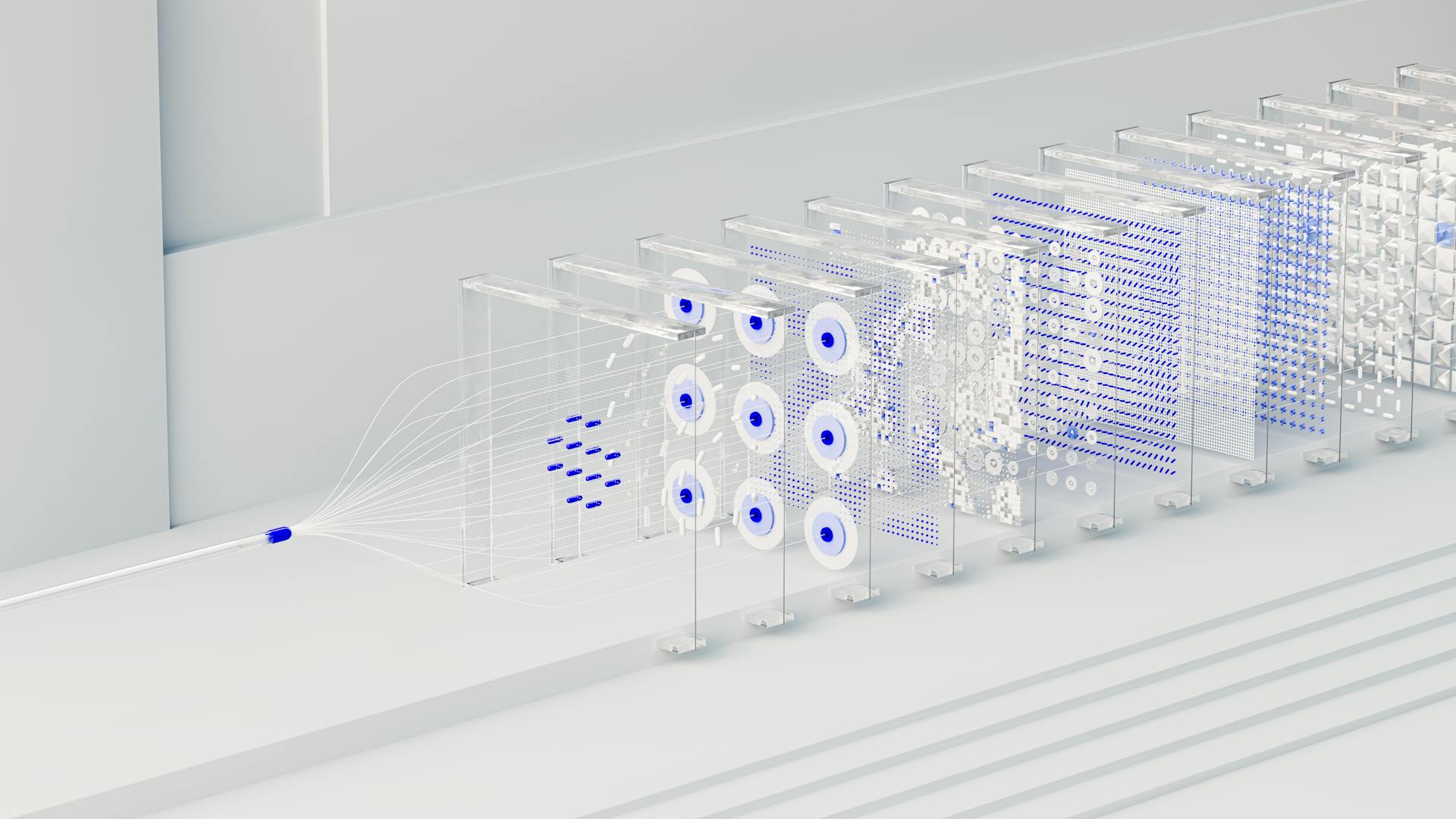
Pre-trained models are like a blank canvas, waiting for you to add your own brushstrokes. They've already learned the basics, but you can still customize them to fit your specific needs.
Pre-trained models have a huge advantage in terms of speed and efficiency, as they can be fine-tuned in a fraction of the time it would take to train from scratch. This is because they've already learned to recognize general patterns and features in data.
Fine-tuning a pre-trained model is like adding a new layer of paint to an existing masterpiece. It builds upon the knowledge and features already learned, allowing you to adapt the model to a specific task or dataset.
A fresh viewpoint: Improving Language Understanding by Generative Pre Training
Training and Evaluation
Training a model from scratch can be a daunting task, especially when it comes to defining the specifications like the number of epochs and loss function.
To train a model, you'll need a large, diverse dataset, which can be time-consuming and resource-intensive. This is because training a model begins with a blank slate, no prior knowledge, and requires extensive data to avoid overfitting and underfitting.
Model training involves basic learning algorithms, building layers, and setting initial hyperparameters, which can be a complex process. However, with the right techniques, you can create a general model capable of learning from data.
Evaluating a model's performance is an essential step, and one common way to do this is by checking its accuracy on an evaluation dataset. This can help you assess the model's performance on its intended purpose.
Fine-tuning a pre-trained model, on the other hand, can be a more efficient process, leveraging existing resources and requiring smaller, specific datasets. This is because fine-tuning starts with a pre-trained model, which has already learned meaningful representations and features from the data.
To fine-tune a model, you'll need to make cautious adjustments, validate new data, and focus on improvement in task-specific performance. This approach emphasizes the importance of hyperparameter tuning, regularization, and adjusting layers to adapt the model to perform better on specific tasks.
Additional reading: Data Science vs Ai vs Ml
Training from Scratch
Training from scratch gives you complete control over your model's architecture, allowing you to tailor it specifically for the task at hand.
This approach ensures that your model doesn't inherit any biases or unwanted features from pre-existing datasets. It's like starting with a blank slate, where you get to decide what features are most important for your model to learn.
Training a model from the ground up can provide deeper insights into the data's features and patterns, leading to a more robust model for specific datasets. I've seen this happen when working with unique datasets that don't fit the mold of existing ones.
Here are some benefits of training from scratch:
- Customization: You have complete control over the model's architecture.
- No Prior Biases: The model doesn't inherit biases or unwanted features from pre-existing datasets.
- Deep Understanding: You gain deeper insights into the data's features and patterns.
- Optimal for Unique Datasets: Training from scratch yields better results for datasets significantly different from existing ones.
Training from scratch might be the better choice for datasets that are significantly different from existing ones, allowing your model to learn features unique to that dataset.
Fine-Tuning Techniques
Fine-tuning techniques are a crucial aspect of working with pre-trained models. They address specific challenges in fine-tuning, contributing to the creation of more accurate and reliable machine-learning models.
Take a look at this: Fine-tuning Huggingface Model with Custom Dataset
One key strategy in fine-tuning is adjusting the learning rates, which makes the fine-tuning process more stable and ensures the model retains previously learned features without drastic alterations.
Freezing the initial layers of the model during the fine-tuning process is another common strategy. This means that these layers won't be updated during training, and as mentioned, the initial layers capture more generic features, so fixing them is often beneficial.
- Pre-Trained Model: begin with a model trained on a large dataset;
- Unfreeze Some Layers: unfreeze a portion of the pre-trained layers so their weights can be updated during training;
- Retrain Model: train both the unfrozen pre-trained layers and the new layers on the new dataset.
This approach, known as Fine Tuning, extends Transfer Learning by not only adding new layers but also retraining some of the pre-trained layers.
Hyperparameter Tuning
Hyperparameter Tuning is a crucial step in fine-tuning models. It involves adjusting the model's parameters to improve performance, such as tuning the learning rate or batch size, which can significantly impact accuracy.
A practical case uses a grid or random search to find the optimal hyperparameters for a classification task. This approach can help identify the best combination of hyperparameters for a specific model and dataset.
You might like: Huggingface Fine Tuning Llm
Hyperparameter tuning can be time-consuming, but it's essential to achieve optimal model performance. By fine-tuning the right parameters, you can improve the accuracy and efficiency of your model.
Here are some common hyperparameters that are often tuned:
- Learning rate
- Batch size
- Number of epochs
- Regularization strength
These hyperparameters can be adjusted using various techniques, such as grid search, random search, or Bayesian optimization. The choice of technique depends on the specific problem and the size of the search space.
By carefully tuning these hyperparameters, you can significantly improve the performance of your model and achieve better results on your dataset.
Data Augmentation
Data augmentation is a powerful technique to enhance the training dataset by creating modified versions of data points. This helps in reducing overfitting.
Rotating, flipping, or adding noise to images is a common way to create a more robust model in image processing. By doing this, you can create a larger, more diverse dataset that the model can learn from.
Data augmentation can be applied to various types of data, not just images. It's a flexible technique that can be used to enhance any type of data point.
You might like: How to Fine Tune Llm on Custom Data
Pre-Trained Models
Pre-trained models are a game-changer in deep learning, saving time and resources needed to train a model from scratch. They've already learned features from large datasets, which can be leveraged for a new task with a smaller dataset.
Pre-trained models are especially useful when acquiring labeled data is challenging or costly. This is because they've already learned generic features like edges or textures, which can be adapted for a new task with minimal updates.
Pre-trained models can be adapted for a new task by adjusting the deeper layers while keeping the initial layers fixed. This approach is called fine-tuning, and it's a common method in transfer learning.
Readers also liked: Pre Trained Multi Task Generative Ai
Initialization of Weights
Random initialization is a common method where weights are assigned random values, ensuring a break in symmetry among neurons, which prevents them from updating similarly during backpropagation.
However, this method can sometimes lead to slow convergence or the vanishing gradient problem.
He initialization, designed for ReLU activation functions, initializes weights based on the size of the previous layer, ensuring that the variance remains consistent across layers.
Xavier initialization, suitable for tanh activation functions, considers the sizes of the current and previous layers, helping with faster and more stable convergence.
Transfer Learning
Transfer Learning is a technique where a model developed for a task is adapted for a second related task. It's a popular approach in deep learning where pre-trained models are used as the starting point for computer vision and natural language processing tasks due to the extensive computational resources and time required to train models from scratch.
Pre-trained models save time and resources needed to train a model from scratch. They have already learned features from large datasets, which can be leveraged for a new task with a smaller dataset.
Transfer learning involves leveraging a pre-trained model, typically trained on a large dataset, and applying it to a new but related problem. This approach harnesses the knowledge the model has already learned, reducing the amount of new data and training time required.
In the context of transfer learning, feature extraction vs fine-tuning dictate how much of the pre-trained model is used and how it's adapted for the new task.
Discover more: What Is Ai Model Training
Here are some examples of how transfer learning is used in different fields:
- Text classification
- Machine translation
- Chatbots and virtual assistants: Employ transfer learning to tailor pre-trained conversational models for distinct industries or corporate environments.
- Image classification: Modify pre-trained vision models for particular datasets using minimal parameter adjustments.
- Object detection: Enhance models to efficiently identify and classify objects in imagery and videos.
- Speech recognition: Adapt extensive pre-trained speech recognition models to specific accents, dialects, or languages.
- Personalize recommendation engines swiftly for distinct user demographics or content categories.
- Medical diagnostics: Apply transfer learning to specialize models on particular medical datasets for aiding in disease diagnosis from images or clinical data.
Parameter-efficient fine-tuning (PEFT) is a technique used in Natural Language Processing (NLP) to improve the performance of pre-trained language models on specific downstream tasks. It involves reusing the pre-trained model’s parameters and fine-tuning them on a smaller dataset.
PEFT achieves this efficiency by freezing some of the layers of the pre-trained model and only fine-tuning the last few layers that are specific to the downstream task. This way, the model can be adapted to new tasks with less computational overhead and fewer labeled examples.
Suggestion: Transfer Learning vs Fine Tuning
Comparative Analysis
In a comparative analysis of popular PEFT methods, we can see that each has its unique strengths and weaknesses. Adapters, for instance, are great for performing multiple tasks on one model, but they come with moderate computational overhead.
Adapters insert neural modules between a model's layers, only updating adapter weights during fine-tuning. This makes them a good choice for flexibility, but not ideal for tasks with limited resources.
LoRA, on the other hand, introduces a low-rank matrix into the attention mechanism to learn task-specific patterns. This makes it suitable for tasks with specialized attention requirements and limited resources.
Prefix Tuning adds a trainable prefix to modify the model's learned representation. This is a low-overhead approach that's ideal for task-specific adaptation with limited resources.
Prompt Tuning modifies the model's hidden states with trainable parameters in response to task-specific prompts. This is a good choice for large pre-trained models that need to adapt to multiple tasks.
P-tuning employs trainable prompt embeddings that encapsulate task-specific information for better adaptability. This is particularly useful in situations requiring precise, contextual modifications without extensive model retraining.
IA3 uses an iterative algorithm to adaptively adjust the importance of attributes in model fine-tuning. This is a good choice for complex scenarios where attribute significance varies.
Here's a comparison of the PEFT methods:
Best Practices and Considerations
Transfer learning can save you a significant amount of time and resources, especially when working with tasks that have limited data.
To develop robust and effective machine-learning models, it's essential to adhere to best practices in model fine-tuning. This includes utilizing pre-trained models as a starting point, expanding training datasets through data augmentation, and implementing regularization techniques like L1 and L2 regularization to prevent overfitting.
Regularization techniques can help prevent overfitting by penalizing model complexity. This is crucial when working with limited data, as it can help improve the model's ability to generalize.
Employing grid search and random search methods for systematic hyperparameter optimization can also be beneficial. This allows you to balance thoroughness and randomness in your optimization process.
Ensemble methods can be used to combine multiple models, improving predictions and leveraging the strengths of diverse approaches. However, this approach requires careful consideration to ensure that the combined models work well together.
Maintaining comprehensive documentation of model development processes is also essential for transparency and future reference. This includes documenting model development processes, as well as the decisions made during the development process.
Here are some key considerations to keep in mind when fine-tuning a pre-trained model:
Collaboration between team members can also benefit from diverse perspectives and expertise in problem-solving and innovation. By working together and sharing knowledge, you can develop more effective machine-learning models.
Frequently Asked Questions
What is the difference between pre-training and fine-tuning and RAG?
Pre-training lays a broad foundation, while fine-tuning adds specificity. RAG further refines this by introducing contextual relevance, making it a powerful tool for precise results.
Sources
- https://datascience.stackexchange.com/questions/113060/difference-between-pretrained-finetune-feature-extract
- https://encord.com/blog/training-vs-fine-tuning/
- https://www.markovml.com/blog/model-fine-tuning
- https://codefinity.com/blog/Fine-Tuning-vs-Feature-Extraction-in-Transfer-Learning
- https://www.leewayhertz.com/parameter-efficient-fine-tuning/
Featured Images: pexels.com


